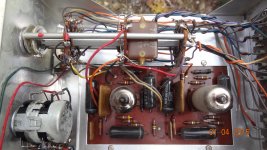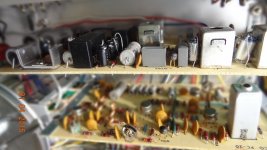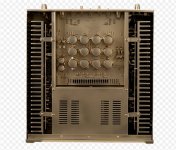Today is the perfect day to let it out and announce a stunning new amplifier topology from me, at BEAR Labs!
Could be useful for playing the lottery. Or to arrive before to start when you need to travel... As long as you don't die before your birth.the scheme works because of the use of advanced, ultra high speed, leading-edge Gallium Arsenide microwave devices. This permits the supporting distortion reduction circuitry to in effect work to cancel the distortion before it happens
Mr Spoke ?
Last edited:
Today is the perfect day to let it out and announce a stunning new amplifier topology from me, at BEAR Labs!
John, I am sure you will fully understand the implications!!
Linked for ease of locating:
http://www.diyaudio.com/forums/solid-state/272340-stunning-amplifier-development-feedforwardback-feedbackforward.html#post4279307
Put me down for 4 of them.
hi folks, Bob C. mentioned bootstrapping in the appnote and i was not quiet sure how it was to be done. i think you cleared it up for me thx to you and bob cheers guysBob Cordell did a fine and lengthy app note for the LSK489, by the way.
You said that all the 1st April of each year.Wow! I guess it's time to retire. '-)
No Joke -
Decades later, some people started testing caps and resistors for distortion... often out of context with the original application; such as RIAA EQ. Caps for example were not of the quality we have today.... such as wax and paper dielectrics. Ceramics and silvered mica were also the norm in the 60's.
Here is a very popular tube preamp (1960's) internal view of the wiring practices and parts quality. It was thought to measure well and sound well also. The Dynaco PAS2. But other brands were about the same. Click on the picture to zoom in on it.

Later with SS starting to replace tubes, this popular DYNA FM5 stereo tuner (1972) was a popular example for audiophiles. Lot of ceramics and electrolytic caps. But now film R's. SS designs were single ended and used similar topology as tubes... still cap coupled I/O and FB..... except now they were electrolytics instead of wax and paper dielectrics -

Until the all direct (DC) coupled SS topology and dc servo, this is what we would have had for an even longer time period in audio history.
The expose on capacitors opened the idea to look at all parts, connections, materials, and pcb etc that we take for granted and enjoy today in our audio products.
THx-RNMarsh
Decades later, some people started testing caps and resistors for distortion... often out of context with the original application; such as RIAA EQ. Caps for example were not of the quality we have today.... such as wax and paper dielectrics. Ceramics and silvered mica were also the norm in the 60's.
Here is a very popular tube preamp (1960's) internal view of the wiring practices and parts quality. It was thought to measure well and sound well also. The Dynaco PAS2. But other brands were about the same. Click on the picture to zoom in on it.

Later with SS starting to replace tubes, this popular DYNA FM5 stereo tuner (1972) was a popular example for audiophiles. Lot of ceramics and electrolytic caps. But now film R's. SS designs were single ended and used similar topology as tubes... still cap coupled I/O and FB..... except now they were electrolytics instead of wax and paper dielectrics -

Until the all direct (DC) coupled SS topology and dc servo, this is what we would have had for an even longer time period in audio history.
The expose on capacitors opened the idea to look at all parts, connections, materials, and pcb etc that we take for granted and enjoy today in our audio products.
THx-RNMarsh
Last edited:
A very clear representation, Richard, of what we had to work with from the 50's, to 1975 or so. I had a Dynaco PAS-3, (a slightly updated version of the PAS-2 shown) for 10 years, before making the Levinson JC-2. There were better preamps from McIntosh and Marantz, but the construction was much the same as the Dyna, etc.
Yes, the DN parts are also an option, although I worry a bit about the body diodes. The DMOS will have a lower impedance presented to the 389 drains owing to the high transconductance, which is a benefit for the removal of Cgd effects in the 389. I'm using some Diodes Inc./Zetex enhancement mode parts in another design and biasing with a current-source-excited parallel R-C, and they seem to work well (ZVN2106, ZVP 3306).
I used the cascode circuit with the depletion mode mosfets from Supertex in the Nuforce preamp. It also has lsk389 input fets and an active current source. No production or reliability problems during the product life and it worked really well. I wish one could get p channel depletion mode mosfets.
And the input impedance becomes very high and distortion low. The input circuit of the Shibasoku distortion analyzer is also very similar and has incredibly low distortion. (I posted it somewhere else on diy audio.)
Now that Supertex is part of Microchip we may see their fets all vanish as Microchip destroys another company.
Worth mentioning here that Infineon has a few signal level (no TO220) N channel depletion mode FETs - N-channel MOSFETs: Depletion MOSFETs (60 - 600V) - Infineon Technologies
In sims of the buffer, there does appear to be a distinct performance enhancement (NPI) using the Zetex parts mentioned, either the ZVN2106 or ZVN3306, in place of the J111. Of course one must bias the gates of the DMOS somehow. One cute but somewhat expensive and inefficient approach uses photovoltaic optocouplers. The parts should be bypassed with enough C.
Any other NEW ideas to make better amps and preamps?
In all seriousness, we are still looking for different ways to make a better sounding amp or preamp. Many of us have found that exotic approaches, such as using feedforward and feedback together, can LOWER distortion, allowing one to start with a higher distortion gain stage, fixing it with advanced feedback techniques, and while measurably commendable, don't necessary improve the sound quality, and in fact, might compromise it.
In all seriousness, we are still looking for different ways to make a better sounding amp or preamp. Many of us have found that exotic approaches, such as using feedforward and feedback together, can LOWER distortion, allowing one to start with a higher distortion gain stage, fixing it with advanced feedback techniques, and while measurably commendable, don't necessary improve the sound quality, and in fact, might compromise it.
This thread? http://www.diyaudio.com/forums/equi...ibasoku-automatic-distortion-analyzer-29.htmlThe input circuit of the Shibasoku distortion analyzer is also very similar and has incredibly low distortion. (I posted it somewhere else on diy audio.)
Any other NEW ideas to make better amps and preamps?
Any other new ideas on proving that the earth is round?
There's a great discussion of that very thing in Waldhauer's book Feedback (ISBN 0471053198).Any other new ideas on proving that the earth is round?
Brad
Audio Impasse...
Where do we go from > -115db noise and a 20ppm amp ?
I see (hear) a point where any further amplifier advancement is a futile
labor with diminishing returns.
I sit a meter away from 200W speakers,(over) powered by a 250w
amp. I hear nothing till the first note. Like the amp is off.
So , do I need a quieter source or amp ?
Lower noise devices , maybe ? To get -120db. Why ? Just to brag ?
That's noise ... then there is distortion. Is 50ppm (.005%) good enough ?
10 - 100 ppm - I can't tell the difference.
Different designs manifest as subtle changes in imaging. Some make
the cymbals/vocals more "believable". Some have better mid bass /
low bass.
Power - much more decisive in the listening experience. >10db
more headroom is "fun" to listen to , especially with a digital source.
is "fun" to listen to , especially with a digital source.
Speakers - A 10ppm amp running on junk speakers - they still
sound like junk speakers (being run with a 10ppm amp).
The (primary) source - The artists and recording studio can put out crap ....
your 10ppm amp will faithfully reproduce this "poop" and it will
sound like the same ???
21'st century designs are "up to snuff" , some "chase their tails" and
spend $$$ to try to fix/improve the wrong things. AND , enterprising
marketers will mislead and profit immensely from this ignorance.
Example - https://emotiva.com/products/amplifiers/xpa-2-g18
(below - google got it !)
Ahh ! "access denied" after my "pitchfork" review - same amp
- same amp
as the XPA-2 with 16,000 $ of gold paint.
OS
Where do we go from > -115db noise and a 20ppm amp ?
I see (hear) a point where any further amplifier advancement is a futile
labor with diminishing returns.
I sit a meter away from 200W speakers,(over) powered by a 250w
amp. I hear nothing till the first note. Like the amp is off.
So , do I need a quieter source or amp ?
Lower noise devices , maybe ? To get -120db. Why ? Just to brag ?
That's noise ... then there is distortion. Is 50ppm (.005%) good enough ?
10 - 100 ppm - I can't tell the difference.
Different designs manifest as subtle changes in imaging. Some make
the cymbals/vocals more "believable". Some have better mid bass /
low bass.
Power - much more decisive in the listening experience. >10db
more headroom
Speakers - A 10ppm amp running on junk speakers - they still
sound like junk speakers (being run with a 10ppm amp).
The (primary) source - The artists and recording studio can put out crap ....
your 10ppm amp will faithfully reproduce this "poop" and it will
sound like the same ???
21'st century designs are "up to snuff" , some "chase their tails" and
spend $$$ to try to fix/improve the wrong things. AND , enterprising
marketers will mislead and profit immensely from this ignorance.
Example - https://emotiva.com/products/amplifiers/xpa-2-g18
(below - google got it !)
Ahh ! "access denied" after my "pitchfork" review
as the XPA-2 with 16,000 $ of gold paint.
OS
Attachments
- Status
- Not open for further replies.
- Home
- Member Areas
- The Lounge
- John Curl's Blowtorch preamplifier part II
